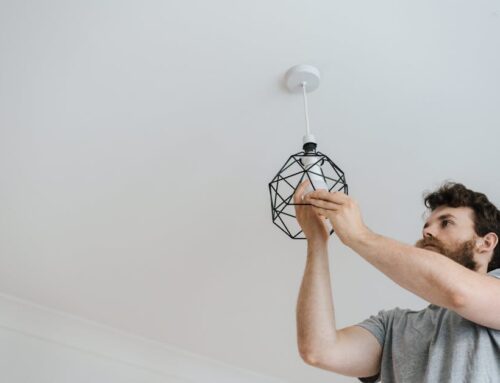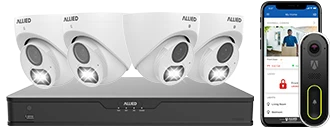Introduction to Home Security Monitoring
In today’s world, the importance of home security cannot be overstated. Home security monitoring has emerged as a vital component in safeguarding homes and offering peace of mind to homeowners. Understanding the fundamental aspects of home security monitoring can provide deeper insights into its significance.
Home security monitoring refers to the real-time supervision of a property’s security systems by a dedicated monitoring service. These systems typically include a combination of alarms, cameras, sensors, and communication devices coordinated to notify homeowners and, if necessary, emergency services of potential intrusions or emergencies.
The Basic Components of Home Security Monitoring
A robust home security monitoring system generally includes several key components:
- Alarm Systems: Devices that alert homeowners of unauthorized entry.
- Surveillance Cameras: Cameras that capture and record footage within and around the property.
- Sensors: Motion, door, and window sensors that detect unusual activities or breaches.
- Control Panels: Central hubs where the system is managed and controlled.
- Communication Links: Mechanisms that connect the system to a monitoring service or directly to emergency services.
The Role of Monitoring Services
Monitoring services play a crucial role in home security. These services continuously observe the data transmitted by home security systems and respond to alarms or alerts. Depending on the system and service provider, responses can range from contacting the homeowner to dispatching emergency responders. This continuous oversight significantly elevates the level of security.
Key Statistics and Facts
Several studies highlight the effectiveness of home security monitoring systems:
| Statistic | Source |
|---|---|
| Homes without security systems are 300% more likely to be burglarized. | FBI Crime Reports |
| 60% of convicted burglars said the presence of a security system influenced their decision to target another home. | University of North Carolina at Charlotte |
These statistics underscore the importance and effectiveness of having a monitored home security system. The proactive detection and rapid response capabilities provided by these systems not only protect property but also ensure the safety and well-being of residents.
Types of Home Security Monitoring Systems
Home security monitoring systems have evolved significantly over the years, offering a variety of solutions tailored to meet different security needs. Understanding the types of home security monitoring systems available can help homeowners make informed decisions about the best option for their specific situation.
Monitored Alarm Systems
Monitored alarm systems are a popular choice for many homeowners. These systems alert a central monitoring station when the alarm is triggered. The monitoring station can then dispatch emergency services as needed. Monitored systems can be categorized into three main types:
- Landline Monitored Systems: These systems use a traditional phone line to communicate with the monitoring station. While reliable, they can be vulnerable if the phone line is cut.
- Cellular Monitored Systems: These systems use a cellular signal to communicate. They are more secure than landline systems but can be affected by signal strength in remote areas.
- Broadband Monitored Systems: These systems use an internet connection to communicate with the monitoring center. They offer fast response times but rely on a stable internet connection.
Unmonitored Alarm Systems
Unmonitored alarm systems are an alternative to monitored systems. When the alarm is triggered, the system emits a loud siren to alert neighbors and frighten intruders. However, it does not notify emergency services. This type of system can be effective in areas with close-knit communities but may not be sufficient for all security needs.
Wireless Security Systems
Wireless security systems use radio frequency technology to communicate between sensors and the control panel. They are easy to install and can be moved or expanded without the need for wiring. Wireless systems are ideal for renters or those who do not want to make permanent alterations to their homes.
Wired Security Systems
Wired security systems are typically more reliable than wireless systems as they are not susceptible to signal interference. However, installation can be more complex and often requires professional assistance. These systems are often chosen by homeowners who plan to stay in their residences long-term.
DIY Security Systems
Do-it-yourself (DIY) security systems are designed for easy installation and can be configured by the homeowner. These systems often come with a variety of components like cameras, motion detectors, and door/window sensors that can be customized to fit specific needs. Additionally, many DIY systems offer optional professional monitoring services.
Smart Home Security Systems
Smart home security systems integrate with other smart home devices, allowing for remote monitoring and control via smartphone apps. These systems can include features like video doorbells, smart locks, and home automation functionalities. They offer the convenience of managing home security from anywhere, providing real-time alerts and the ability to monitor activities from a mobile device.
Each type of home security monitoring system has its own set of features, advantages, and potential drawbacks. By understanding these different systems, homeowners can choose the solution that best fits their security requirements and lifestyle.
Benefits of Home Security Monitoring
Home security monitoring offers multiple benefits, promoting not only the safety of property and personal belongings but also enhancing the overall sense of security for homeowners.
Deterrence of Criminal Activity
One of the primary benefits of home security monitoring is its effectiveness in deterring criminal activity. According to data from the FBI, homes without security systems are up to 300% more likely to be broken into. Visible surveillance cameras and security signs can serve as a strong deterrent, discouraging potential intruders from attempting a break-in.
Quick Emergency Response
Many home security monitoring systems are integrated with services that can immediately alert emergency responders in the event of a break-in, fire, or medical emergency. This rapid response can be crucial in mitigating damage or harm. For instance, monitored burglar alarms can trigger law enforcement dispatch within minutes.
Remote Monitoring and Control
With advancements in technology, many home security systems now offer remote monitoring capabilities. Homeowners can access live feeds from security cameras, control alarms, and even lock or unlock doors from their smartphones. This remote access allows for real-time monitoring and control, regardless of the homeowner’s location.
Reduction in Homeowner’s Insurance Premiums
Installing a home security system can lead to savings on homeowner’s insurance premiums. Many insurance companies offer discounts of up to 20% for homes equipped with security monitoring systems. These savings, over time, can help offset the cost of the security system.
Peace of Mind
The psychological benefit of home security should not be underestimated. Knowing that one’s home is protected can provide significant peace of mind. This sense of security can improve overall quality of life, reducing stress and anxiety related to potential threats.
Environmental Monitoring
Modern home security systems often include sensors for environmental hazards such as smoke, carbon monoxide, and water leaks. Early detection of these dangers can prevent extensive property damage and safeguard the health of occupants.
Enhanced Home Automation Integration
Many security systems integrate with home automation systems, allowing for seamless control of various aspects of the home environment, such as lighting, heating, and cooling. This integration can lead to increased convenience, energy savings, and a more customized living experience.
- Deterrence of criminal activity
- Quick emergency response
- Remote monitoring and control
- Reduction in homeowner’s insurance premiums
- Peace of mind
- Environmental monitoring
- Enhanced home automation integration
Current Trends and Innovations in Home Security
Home security monitoring systems are continually evolving to incorporate the latest technological advancements. These innovations aim to enhance the security and convenience offered to homeowners. Some of the recent trends include integration with smart home devices, the use of artificial intelligence (AI) and machine learning, and advancements in sensor technology.
Integration with Smart Home Devices: Modern home security systems increasingly offer compatibility with various smart home devices. This allows users to control not only their security systems but also lighting, heating, and other household functions through a single interface. Companies like ADT and Vivint provide options for integrating security systems with platforms like Amazon Alexa and Google Home.
Artificial Intelligence (AI) and Machine Learning: AI and machine learning are becoming pivotal in the realm of home security monitoring. These technologies enable systems to distinguish between everyday activities and potential security threats more accurately. For instance, AI-powered cameras can recognize faces, reducing the likelihood of false alarms caused by familiar individuals. A report from MarketsandMarkets suggests that the AI in the home security market is expected to grow from $2.5 billion in 2020 to $9 billion by 2025.
Advancements in Sensor Technology: New sensors can detect a range of conditions, including movement, glass breaking, and even environmental changes such as temperature and humidity variations. These sophisticated sensors contribute to a more holistic security solution by providing early warnings for various types of incidents. Companies like Ring and SimpliSafe are leading the way with advanced sensor technologies.
Below is a table summarizing some of the key players and their innovative offerings in the home security market:
| Company | Innovative Offering |
|---|---|
| ADT | Integration with smart home devices and advanced AI monitoring |
| Vivint | Comprehensive smart home integration with advanced detection capabilities |
| Ring | Enhanced sensor technology for comprehensive monitoring |
| SimpliSafe | Advanced environmental sensors and easy DIY installation options |
Overall, these trends and innovations signify a move towards more intelligent, integrated, and user-friendly home security solutions. The ongoing advancements reflect the growing demand for systems that do more than just protect homes, enhancing convenience and efficiency in daily life.
Statistical Analysis of Home Security Effectiveness
Statistical analysis provides concrete insights into the effectiveness of home security monitoring systems. According to the FBI’s Uniform Crime Reporting (UCR) Program, in 2019, there were approximately 1.1 million burglaries in the United States. However, the National Council for Home Safety and Security reports that homes without security systems are 300% more likely to be broken into. This underscores the significant deterrent effect that security systems provide.
Furthermore, data from the Electronic Security Association (ESA) suggest that 90% of convicted burglars say they would avoid targeting a home with an obvious security system. This alarm-based deterrence significantly contributes to crime prevention.
A study conducted by the University of North Carolina at Charlotte found that 60% of burglars surveyed indicated the presence of a security system would cause them to seek an alternative target. The critical role of monitored systems is highlighted by the fact that police respond faster to alarms from monitored security systems compared to those without monitoring, potentially reducing the average intrusion time.
Insurance companies acknowledge the benefits of home security monitoring as well. Homeowners with monitored systems often receive discounts on their home insurance premiums, with reductions ranging from 5% to 20%, depending on the provider and the comprehensiveness of the system.
Conclusively, statistical evidence supports the assertion that home security monitoring systems are effective in reducing burglary rates, deterring criminals, and even saving homeowners money through insurance discounts.
Common Challenges and Solutions in Home Security Monitoring
Home security monitoring serves as a crucial element in safeguarding residential properties, but it is not without its challenges. Understanding these common issues and recognizing effective solutions can optimize the performance and reliability of security systems.
Technical Glitches and Connectivity Issues
One of the primary challenges in home security monitoring involves technical glitches and connectivity problems. Network disruptions can cause significant gaps in security coverage, leaving homes vulnerable during these periods. To overcome these issues, homeowners can:
- Use a reliable internet service provider: Ensuring a robust and stable internet connection minimizes the risk of disconnection.
- Optimize router placement: Placing the router in a central location can improve signal strength.
- Invest in backup systems: Redundant connections, like cellular backups, can maintain coverage during internet outages.
False Alarms
False alarms are another significant problem for homeowners and security services. They can be triggered by pets, environmental factors, or system malfunctions. Strategies to reduce false alarms include:
- Improving sensor technology: Advanced sensors can better differentiate between humans and pets.
- Regular system maintenance: Checking and maintaining the system can prevent many false alarms caused by technical issues.
- Proper system configuration: Ensuring that the security system is correctly configured to the home’s layout can reduce unnecessary triggers.
Privacy Concerns
Privacy concerns are another common challenge associated with home security monitoring. Surveillance systems often capture images and video that can be sensitive. Solutions to address these concerns include:
- Encrypting data: Ensuring that all captured data is encrypted can protect against unauthorized access.
- Access controls: Limiting access to the security footage to authorized personnel only.
- Transparency policies: Clearly communicating the use of surveillance to all residents and visitors can alleviate privacy issues.
System Cost and Affordability
Cost is another barrier for many homeowners interested in home security monitoring. Comprehensive systems can be expensive to install and maintain. Solutions to reduce costs include:
- DIY installation: Self-installation can significantly cut down on initial expenses.
- Utilizing smart devices: Integrating existing smart home devices can enhance security without substantial additional costs.
- Monitoring services comparison: Comparing costs and services of different monitoring companies can help find the most cost-effective option.
By addressing these common challenges through strategic solutions, homeowners can enhance the reliability and effectiveness of their home security monitoring systems, ultimately ensuring better protection for their properties and peace of mind for themselves.
Legal and Ethical Considerations in Home Security Monitoring
Home security monitoring involves several legal and ethical dimensions that homeowners must consider to ensure they are compliant with existing laws and respectful of privacy rights. Understanding these considerations is crucial for the responsible implementation of home security systems.
Legal Aspects
Several laws and regulations govern home security monitoring, which can vary significantly by jurisdiction. Key legal considerations include:
- Notification Requirements: In many regions, it is legally required to inform individuals that they are being monitored. This can include posting visible signs indicating the presence of security cameras.
- Restrictions on Audio Recording: Audio recording often faces stricter regulations compared to video surveillance. Some jurisdictions require explicit consent from all recorded parties.
- Public vs. Private Spaces: While monitoring private property is generally permissible, surveillance of public areas or property outside one’s own premises can lead to legal challenges.
- Data Protection Law: Regulations like the General Data Protection Regulation (GDPR) in the European Union set strict guidelines on how recorded data should be stored, processed, and shared. Breach of these regulations can result in severe penalties.
Ethical Considerations
Beyond legal compliance, there are several ethical issues related to home security monitoring:
- Privacy of Family Members: Continuous surveillance can intrude on the privacy of those living in the home. It is essential to balance security needs with the right to privacy, especially in intimate spaces within the home.
- Use of Recorded Data: Ethical considerations extend to how recorded data is used and who has access to it. Data should only be used for the purpose it was collected for and should be protected from unauthorized access.
- Transparency and Consent: All occupants should be informed and consent to the monitoring practices. This transparency fosters trust and cooperation among household members.
Best Practices
To navigate the legal and ethical complexities of home security monitoring, consider implementing the following best practices:
- Clear Notification: Post clear signs indicating the use of security cameras, especially in areas where visitors or service providers might enter.
- Limited Audio Recording: Avoid audio recording unless absolutely necessary and ensure all parties are informed and have given consent.
- Respect for Private Spaces: Avoid installing cameras in private areas such as bathrooms and bedrooms to maintain personal privacy.
- Data Protection Measures: Implement robust data protection measures to secure recorded data, including encryption and access controls.
- Regular Policy Reviews: Periodically review your security monitoring policies to ensure they remain in compliance with current laws and ethical standards.
By understanding and adhering to these legal and ethical considerations, homeowners can create a secure environment that respects the rights and privacy of all individuals involved.
Future Outlook for Home Security Monitoring
The future outlook for home security monitoring is shaped by continuous advancements in technology, evolving consumer needs, and the ever-growing demand for enhanced safety measures. This chapter explores key trends, emerging technologies, and the potential impact on the home security industry.
1. Integration with Smart Home Ecosystems
One of the most significant trends is the integration of home security systems with smart home ecosystems. This includes the seamless functioning of security cameras, sensors, and alarms with other smart devices such as lighting, thermostats, and voice assistants. According to a report by MarketsandMarkets, the global smart home market is projected to grow from $78.3 billion in 2020 to $135.3 billion by 2025.
2. Advancements in Artificial Intelligence and Machine Learning
Artificial Intelligence (AI) and Machine Learning (ML) are poised to revolutionize home security monitoring. These technologies enable systems to learn from data, predict potential security breaches, and provide more accurate alerts. For instance, AI-powered cameras with facial recognition capabilities can differentiate between family members and intruders. According to a 2021 study by Tractica, revenue from AI software in the security market is expected to reach $34.3 billion by 2025.
3. Enhanced Cybersecurity Measures
With the increasing connectivity of home security systems, cybersecurity has become a critical concern. Future home security solutions will need robust encryption and secure communication protocols to protect against cyber threats. The National Institute of Standards and Technology (NIST) emphasizes the importance of adopting comprehensive cybersecurity frameworks to safeguard connected devices.
4. Expansion of DIY Security Options
The demand for Do-It-Yourself (DIY) home security systems is on the rise, driven by their affordability and ease of installation. The DIY security market is expected to grow at a compound annual growth rate (CAGR) of 22.4% from 2021 to 2028, according to a report by Allied Market Research. These systems often offer flexible monitoring options, allowing homeowners to self-monitor or subscribe to professional services.
5. Greater Accessibility and User-Friendly Interfaces
Future home security systems will focus on enhancing user experience with more intuitive and accessible interfaces. This includes mobile apps that offer real-time monitoring, remote control functionalities, and easy-to-understand analytics. The aim is to make advanced security solutions accessible to a wider audience, including those who may not have technical expertise.
6. Sustainability and Energy Efficiency
As environmental concerns become more prominent, future home security systems will likely incorporate energy-efficient and sustainable practices. This may involve the use of solar-powered cameras and sensors, as well as systems designed to optimize energy usage. The International Energy Agency (IEA) advocates for increased adoption of energy-efficient technologies to reduce carbon footprints.
In conclusion, the future of home security monitoring is set to be shaped by technological advancements, increased cybersecurity measures, consumer preferences for DIY options, and a focus on sustainability. These developments promise to provide more comprehensive, efficient, and user-friendly security solutions for homeowners.













